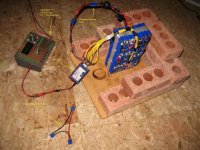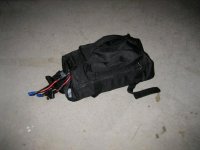patrick_mahoney
100 W
I'd originally posted up a long battery-pack creation thread over at the old Visforvoltage site, and I've been waiting for that site to do some form of resurrection so that I could re-post it here, but I think I've given up hope. So here is my battery build thread, re-written for Endless-sphere.
About a year ago, I was riding to work with my Wilderness Energy BL-36 kit. I had a 3 cell 12V 12Ah SLA pack and it weighed about 28lbs. I would ride it in to work, carry it up four flights of stairs and then charge it at my desk, and all was well. But I was riding at about 20mph and I wished I could get the bike going a bit faster. Then I discovered visforvoltage and found that many were riding their BL-36's at 48V and that this gave them a nice speed boost. I bought another 12V 12Ah battery and made a wooden case for the 4 pack and rode it and was riding up around 25mph and this was much better. But I found that somehow 35lbs carried up 4 flights up stairs at work seemed excessive - whereas somehow 28lbs merely seemed "really heavy". Besides now I needed another charger and a better case.
So I started to look at other - lighter - batteries. My goals were: under 20lbs, more than 12Ah capacity, better than 40V (ideally 48V) and under or around $400. I wanted about 12-15Ah of capacity so that I could travel to and from work roundtrip - with extra capacity for errands - and not have to recharge at work because I'd then have to carry the chargers with me everywhere.
I already had a decent Triton SLA, NiCd, NiMH, lithium-ion, lithium polymer charger ( http://www.rc-hobbies.com/product_pages/gp-triton-dc-charger ) and I had a very nice Astroflight 109 lithium charger ( http://www.aeromicro.com/catalog/astroflight_109_deluxe_digital_battery_charger_discharger_2691678.htm ) from flying model airplanes.
For my new pack, I looked at NiMH, lithium ion and lithium polymer. With NiMH, >10Ah put me in the realm of F-cells, which to this day are not particularly attractive to me from either a capacity per weight, or a capacity per dollar perspective. Looking at D-sized NiMH, at the time - and oh how prices have changed on both nickel-based cells and lithium-based cells - 40 D-sized 10Ah were $5.25/each in quantities of 21-50. I spent a while analyzing pricing and thinking about how I would build the pack, and eventually homed in on 3.6V 2Ah 18650 lithium ion batteries as the batteries that I wanted to use. At the time, I could get a 48V 10Ah NiMH (40s1p of 1.2V 10Ah) pack for $210 that weighed 14.1lbs rated for 16A max discharge, or a 48V 10Ah 18650-based lithium ion (13s5p of 3.6V 2Ah) for $260 that weighed 6lbs rated for 15A max discharge. Both discharge ratings were from the manufacturer. So $210 for 14lbs, or $260 for 6lbs. I chose the lighter.
The problem, as was clear even in those days before Dell recalled 4.1 million battery packs, was that 18650's are not known to be the safest of battery technologies to use. They are used widely in applications - most notably laptop batteries - but their use requires a pretty good battery management system.
But I saw that All-battery.com was listing 18650 cells with built-in battery protection circuitry for a price that was under $3.70/cell with a 15% off coupon that they had emailed as part of their weekly special. I thought for a while about it, and then bought them. I purchased 101 cells - of which I planned to use 96 - with the extras planned in case I had some marginal cells. I called, double-checked that the cells really did come with built-in BMS circuitry, and placed the order. As I recall, I paid about $350 including shipping - but since I phoned my order in, I don't have an email to check this.
The cells that I chose are these - although the prices have changed a bit in the last year:
http://www.all-battery.com/index.asp?PageAction=VIEWPROD&ProdID=1139
Within a couple of hours, someone from all-battery.com called me and said that they didn't have enough 3.6V 2000mAh 18650's to fill the order and asked if I would take 3.6V 2200mAh 18650's instead. I asked if these 2200mAh batteries came with the same over-charging, over-discharging protection circuitry as the 2000mAh cells and was assured that they had the same safety features - only the capacity was different. So, of course, I agreed to 10% higher capacity for free.
Attached is a photo of the cells that I bought - although mine arrived as 2200mAh, not 2000mAh. It's interesting to compare this price, with the prices today.
About a year ago, I was riding to work with my Wilderness Energy BL-36 kit. I had a 3 cell 12V 12Ah SLA pack and it weighed about 28lbs. I would ride it in to work, carry it up four flights of stairs and then charge it at my desk, and all was well. But I was riding at about 20mph and I wished I could get the bike going a bit faster. Then I discovered visforvoltage and found that many were riding their BL-36's at 48V and that this gave them a nice speed boost. I bought another 12V 12Ah battery and made a wooden case for the 4 pack and rode it and was riding up around 25mph and this was much better. But I found that somehow 35lbs carried up 4 flights up stairs at work seemed excessive - whereas somehow 28lbs merely seemed "really heavy". Besides now I needed another charger and a better case.
So I started to look at other - lighter - batteries. My goals were: under 20lbs, more than 12Ah capacity, better than 40V (ideally 48V) and under or around $400. I wanted about 12-15Ah of capacity so that I could travel to and from work roundtrip - with extra capacity for errands - and not have to recharge at work because I'd then have to carry the chargers with me everywhere.
I already had a decent Triton SLA, NiCd, NiMH, lithium-ion, lithium polymer charger ( http://www.rc-hobbies.com/product_pages/gp-triton-dc-charger ) and I had a very nice Astroflight 109 lithium charger ( http://www.aeromicro.com/catalog/astroflight_109_deluxe_digital_battery_charger_discharger_2691678.htm ) from flying model airplanes.
For my new pack, I looked at NiMH, lithium ion and lithium polymer. With NiMH, >10Ah put me in the realm of F-cells, which to this day are not particularly attractive to me from either a capacity per weight, or a capacity per dollar perspective. Looking at D-sized NiMH, at the time - and oh how prices have changed on both nickel-based cells and lithium-based cells - 40 D-sized 10Ah were $5.25/each in quantities of 21-50. I spent a while analyzing pricing and thinking about how I would build the pack, and eventually homed in on 3.6V 2Ah 18650 lithium ion batteries as the batteries that I wanted to use. At the time, I could get a 48V 10Ah NiMH (40s1p of 1.2V 10Ah) pack for $210 that weighed 14.1lbs rated for 16A max discharge, or a 48V 10Ah 18650-based lithium ion (13s5p of 3.6V 2Ah) for $260 that weighed 6lbs rated for 15A max discharge. Both discharge ratings were from the manufacturer. So $210 for 14lbs, or $260 for 6lbs. I chose the lighter.
The problem, as was clear even in those days before Dell recalled 4.1 million battery packs, was that 18650's are not known to be the safest of battery technologies to use. They are used widely in applications - most notably laptop batteries - but their use requires a pretty good battery management system.
But I saw that All-battery.com was listing 18650 cells with built-in battery protection circuitry for a price that was under $3.70/cell with a 15% off coupon that they had emailed as part of their weekly special. I thought for a while about it, and then bought them. I purchased 101 cells - of which I planned to use 96 - with the extras planned in case I had some marginal cells. I called, double-checked that the cells really did come with built-in BMS circuitry, and placed the order. As I recall, I paid about $350 including shipping - but since I phoned my order in, I don't have an email to check this.
The cells that I chose are these - although the prices have changed a bit in the last year:
http://www.all-battery.com/index.asp?PageAction=VIEWPROD&ProdID=1139
Within a couple of hours, someone from all-battery.com called me and said that they didn't have enough 3.6V 2000mAh 18650's to fill the order and asked if I would take 3.6V 2200mAh 18650's instead. I asked if these 2200mAh batteries came with the same over-charging, over-discharging protection circuitry as the 2000mAh cells and was assured that they had the same safety features - only the capacity was different. So, of course, I agreed to 10% higher capacity for free.
Attached is a photo of the cells that I bought - although mine arrived as 2200mAh, not 2000mAh. It's interesting to compare this price, with the prices today.







